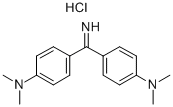General Description
Yellow flakes or powder.
Reactivity Profile
AURAMINE O(2465-27-2) is incompatible with strong oxidizing agents.
Air & Water Reactions
Insoluble in water.
Hazard
Probable carcinogen.
Potential Exposure
Auramine is used industrially as a dye
or dye intermediate for coloring textiles; paper, and leather.
Also used as an antiseptic (a powerful antiseptic in ear and
nose surgery, and treatment of gonorrhea) and fungicide.
Human exposure to auramine occurs principally through
skin absorption or inhalation of vapors. Low-level dermal
exposure to the consumer may occur but would be limited
to any migration of auramine from fabric, leather, or paper
goods.
Fire Hazard
Flash point data for this chemical are not available. AURAMINE O is probably combustible.
First aid
Move victim to fresh air. Call 911 or emergency
medical service. Give artificial respiration if victim is not
breathing. Do not use mouth-to-mouth method if victim
ingested or inhaled the substance; give artificial respiration
with the aid of a pocket mask equipped with a one-way
valve or other proper respiratory medical device.
Administer oxygen if breathing is difficult. Remove and
isolate contaminated clothing and shoes. In case of contact
with substance, immediately flush skin or eyes with running
water for at least 20 minutes. For minor skin contact,
avoid spreading material on unaffected skin. Keep victim
warm and quiet. Effects of exposure (inhalation, ingestion
or skin contact) to substance may be delayed. Ensure that
medical personnel are aware of the material(s) involved
and take precautions to protect themselves. Medical observation
is recommended for 24 to 48 hours after breathing
overexposure, as pulmonary edema may be delayed. As
first aid for pulmonary edema, a doctor or authorized paramedic
may consider administering a drug or other inhalation
therapy.
Shipping
UN2811 Toxic solids, organic, n.o.s., Hazard
Class: 6.1; Labels: 6.1-Poisonous materials, Technical
Name Required. UN3143 Dyes, solid, toxic, n.o.s. or Dye
intermediates, solid, toxic, n.o.s., Hazard Class: 6.1;
Labels: 6.1-Poisonous materials, Technical Name Required.
Incompatibilities
Incompatible with oxidizers (chlorates,
nitrates, peroxides, permanganates, perchlorates, chlorine,
bromine, fluorine, etc.); contact may cause fires or explosions.
Keep away from alkaline materials, strong bases,
strong acids, oxoacids, epoxides.
Chemical Properties
Auramine is a yellow crystalline powder or
flaky material.
Chemical Properties
yellow powder
Waste Disposal
Consult with environmental
regulatory agencies for guidance on acceptable disposal
practices. Generators of waste containing this contaminant
(≥100 kg/mo) must conform with EPA regulations governing
storage, transportation, treatment, and waste disposal.
Incinerate in furnace with afterburner and scrubber.
Uses
Certified for use by fluorescence microscopy in Churukian's modification of Truant's fluorescent method for acid fast bacilli on paraffin sections.
Uses
Fluorescent stain for acid-resistant bacteria in sputum
Definition
ChEBI: A hydrochloride obtained by combining 4,4'-carbonimidoylbis(N,N-dimethylaniline) with one molar equivalent of hydrogen chloride. A fluorescent stain for demonstrating acid fast organisms in a method similar to the Zieh
Neelsen. It also can be used to make a fluorescent Schiff reagent.
Biological Activity
Auramine O is used for the staining of acid-fast organismscoccidia. Auramine O along with carbol generates brilliant yellow fluorochrome of tubercle bacilli. It is effective in detecting positive cases of tuberculosis. Auramine O binds to the mycolic acid in the bacterial cell wall.
Properties and Applications
|
TEST ITEMS
|
SPECIFICATION
|
|
APPEARANCE
|
DARK YELLOWPOWDER
|
|
SHADE
|
BRIGHT YELLOWISH
|
|
HEAT RESISTANCE
|
280 °C min
|
|
DENSITY
|
1.07 g/cm
3
|
|
WATER FASTNESS
|
4-5
|
|
LIGHT FASTNESS
|
1-2
|
|
BLEACHABILITY (OXIDATIVE)
|
4
|
|
BLEACHABILITY (REDUCTIVE)
|
3
|
|
WATER SOLUBILITY AT
20
°C
|
10 g/L min
|
|
WATER INSOLUBLE
|
1.0% max
|
|
MOISTURE
|
3.0% max
|
|
TINTING STRENGTH
|
100-105 %
|
|
WEIGHT METAL TOTAL
|
50ppm max
|
Purification Methods
It crystallises from EtOH as the hydrochloride and is very slightly soluble in CHCl3, UV: 434nm ( 370). The free base (carbinolamine) has m 136o (from *C6H6). [Goldacre & Phillips J Chem Soc 1724 1949, Conrad et al. Biochemistry 9 1540 1970, Beilstein 14 IV 256.]
